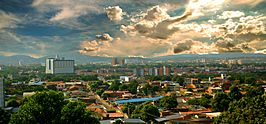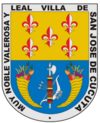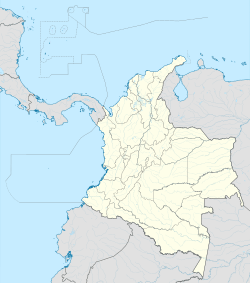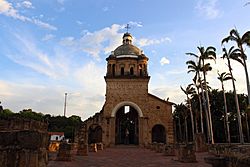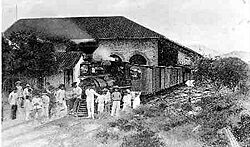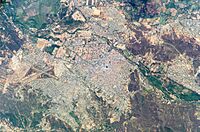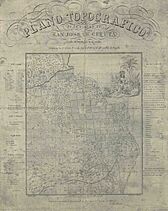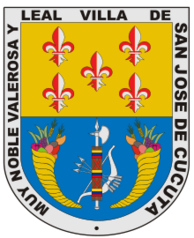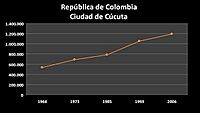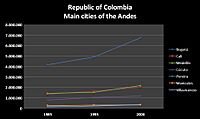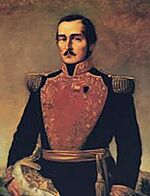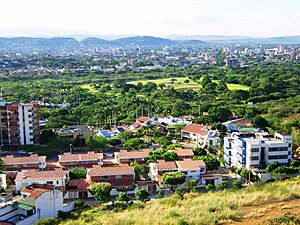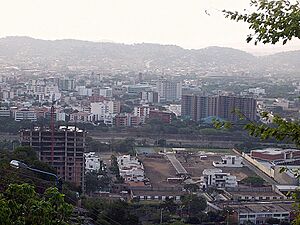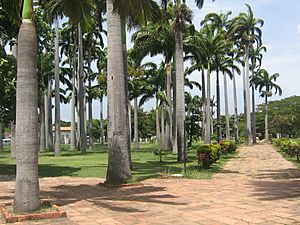Cúcuta facts for kids
Quick facts for kids
San José de Cúcuta
|
|||
|---|---|---|---|
|
Municipality of Colombia
|
|||
|
From above and from left side to right: Skyline of Cúcuta, Cúcuta's esplanade, Cultural Center Quinta Teresa, Monument to Simón Bolívar in the homonymous park, Monument to Battle of Cúcuta and North-east of the city with Erasmo Meoz Hospital.
|
|||
|
|||
| Nickname(s):
The Pearl of the North, Gate of the Border, Green City, City of Trees, The Basketball Capital of Colombia
|
|||
| Motto(s):
Very Noble, Valiant and Loyal Village
|
|||
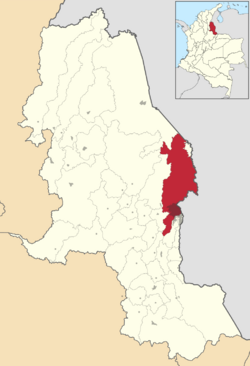
Cúcuta in Department of Norte de Santander. Urbanized area in dark gray, municipality in red.
|
|||
| Country | |||
| Department | Norte de Santander | ||
| Foundation | June 17, 1733 | ||
| Founded by | Juana Rangel de Cuéllar | ||
| Area | |||
| • Municipality of Colombia | 1,119 km2 (432 sq mi) | ||
| • Water | 0 km2 (0 sq mi) | ||
| Elevation | 320 m (1,050 ft) | ||
| Population
(2018 Census)
|
|||
| • Municipality of Colombia | 777,106 | ||
| • Density | 694.46/km2 (1,798.7/sq mi) | ||
| • Urban | 748,948 | ||
| • Metro | 1,046,347 | ||
| Demonym(s) | Cucuteño(a) | ||
| Time zone | UTC−5 (COL) | ||
| Postal code |
540000-19
|
||
| Area code(s) | 57 + 7 | ||
Cúcuta (Spanish: [ˈkukuta]), officially called San José de Cúcuta, is a big city in Colombia. It is the capital of the Norte de Santander region. The city is in a valley at the base of the Eastern Mountains of the Colombian Andes. It is also right on the border with Venezuela.
Cúcuta covers about 1,119 square kilometers. A smaller part, 64 square kilometers, is the city area, divided into 10 sections called communes. The rest is rural land, divided into 10 townships. About 777,106 people live in Cúcuta, making it the sixth largest city in Colombia. If you include nearby towns like Villa del Rosario and Los Patios, the total population is over 1 million.
The city was started on June 17, 1733, by Juana Rangel de Cuéllar. She named it San José de Guasimales. Later, its name changed to San José de Cúcuta. "Cúcuta" comes from "Kuku-ta," honoring the native people. In 1792, King Charles IV of Spain gave it the title "Very Noble, Valiant and Loyal Village."
Cúcuta is a very important city for its region. It is a center for politics, business, industry, art, culture, sports, and tourism. It's also a key city on the border with Venezuela, especially for trade. Many important historical events happened here. These include the Battle of Cúcuta in 1813 and the Congress of Cúcuta in 1821. The city has also played a big role in how Colombia and Venezuela relate to each other.
As the capital, Cúcuta is home to important government offices. It has good road connections to other major Colombian cities like Bogotá and Bucaramanga. It also has an international airport, the Camilo Daza International Airport. The main university here is the Francisco de Paula Santander University.
Contents
- What Does Cúcuta Mean?
- Cúcuta's History: Key Events
- Geography and Climate
- City Symbols: Flag, Coat of Arms, and Anthem
- Population and Famous People
- Cúcuta's Economy
- Transportation in Cúcuta
- Education in Cúcuta
- Sports in Cúcuta
- Recent City Developments
- Cúcuta's Landscape
- Historic Sites
- International Connections
- Images for kids
- See also
What Does Cúcuta Mean?
The city's full name, San José de Cúcuta, has two parts. "San José" honors Saint Joseph, a very common name in Spanish-speaking countries. "Cúcuta" comes from "Kuku-ta." This was the name of a leader of the Motilon-Bari indigenous group. They lived in this area before the Spanish arrived. In their language, "Kuku-ta" means "House of the Goblin." The city was called San José de Guasimales from 1733 to 1793.
Cúcuta's coat of arms has a special saying: "Very Noble, Valiant and Loyal Village of San José de Cúcuta." King Charles IV of Spain gave the city this title in 1792. This was to recognize the hard work of its people.
The city also has several nicknames. These include "The Pearl of the North," "Gate of the Border," "Green City," "City of Trees," and "The Basketball Capital of Colombia."
Cúcuta's History: Key Events
Cúcuta was first a settlement for native people. Juana Rangel de Cuellar officially founded the city on June 17, 1733. She gave away 782 hectares of land for a church and homes for Spanish families. The village grew quickly because it was in a good spot for trade. Eventually, it became a city.
Many important events for Colombia's independence happened here. The Congress of Cúcuta in 1821 created the first constitution for Greater Colombia. This new country included what is now Colombia, Venezuela, Ecuador, and Panama. You can still visit places where these events took place, like the Historical Church of Cúcuta.
The Battle of Cúcuta on February 28, 1813, was also very important. This battle, led by Simón Bolívar, started the "Admirable Campaign." This campaign helped Venezuela gain its independence.
Early European Explorers (16th Century)
The first European to explore this area was a German explorer named Ambrosio Alfinger. He arrived in 1530 from Venezuela. He was looking for gold and fought with local tribes. Alfinger was killed near present-day Chinácota. Other explorers also tried to enter the area but faced strong resistance from the native people.
In 1549, Spanish troops founded Pamplona nearby. This new town became popular because of its good climate and gold mines. More expeditions from Pamplona helped the Spanish take control of the region.
How Cúcuta Was Founded (17th Century)
In the early 1600s, much of the Cúcuta valley belonged to Captain Christopher de Araque Ponce de Leon. Later, his son inherited the land. The native Motilones people resisted the Europeans who were taking over their land. Because of this, people asked for a Catholic church to be built.
Juana Rangel de Cuéllar then donated 782 hectares of land on June 17, 1733. This land was for building a church and homes for Spanish families. Today, this area is the San Luis neighborhood.
Major Events in the 1800s
The Battle of Cúcuta (1813)
The Battle of Cúcuta was a key event in the fight for independence from Spain. It marked the start of Simón Bolívar's "Admirable Campaign." On February 28, 1813, Bolívar and his 400 men fought 800 Spanish troops. The battle lasted for hours, and Bolívar's forces won. This victory freed Cúcuta and helped lead to Venezuela's independence.
The Congress of Cúcuta (1821)
On August 30, 1821, the Congress of Cúcuta took place. It was held in a church in Villa del Rosario, which is now part of Cúcuta. Important leaders like Francisco de Paula Santander and Simón Bolívar attended.
The main goal was to unite the lands of New Granada (Colombia and Panama) and Venezuela. They wanted to create a large country called the Republic of Colombia, or Gran Colombia. Later, Ecuador also joined. On October 3, 1821, Simón Bolívar was sworn in as the first president of this new republic.
The Great Earthquake of 1875
On May 18, 1875, a strong earthquake hit Cúcuta. It is known as the "Earthquake of the Andes." The earthquake destroyed much of Cúcuta and nearby towns. It also caused serious damage in Venezuelan settlements. The shaking was felt as far away as Bogotá and Caracas.
Industrial Growth and Railroads
In the 1800s, building a railroad helped Cúcuta grow industrially. The railroad connected Cúcuta to Puerto Santander and Venezuela. It also had branches linking to other Colombian towns. However, the railroad company went bankrupt and closed in 1960.
Many historic buildings from this time are still preserved. These include the House of Santander and the historic church. They are part of the Park of Greater Colombia.
Geography and Climate
Where is Cúcuta Located?
Cúcuta is in the eastern part of the Norte de Santander region. It is in the Eastern Mountain Range, very close to the border with Venezuela. The city covers about 110 square kilometers. It is about 320 meters (1,050 feet) above sea level.
Rivers in and around Cúcuta include the Pamplonita River, Guaramito River, and Zulia River. The Pamplonita River flows through the Norte de Santander region.
| Zones
(Comunas) |
Small towns
(Corregimientos) |
Settlements
(Caseríos) |
|---|---|---|
|
|
|
Cúcuta's Climate
Cúcuta has a tropical savanna climate. This means it's generally hot all year round. The average temperature is about 27.6°C (81.7°F). Afternoon temperatures often reach around 32°C (90°F).
The city has clear wet and dry seasons. The driest months are January, February, June, and July. The wettest months are April, May, September, October, and November. Even in June and July, there can be light rain and fog. August is usually sunny and windy. The city gets about 900 mm (35 inches) of rain each year. Higher areas near the city are cooler and wetter.
| Climate data for Cúcuta (Camilo Daza International Airport) 1991–2020 | |||||||||||||
|---|---|---|---|---|---|---|---|---|---|---|---|---|---|
| Month | Jan | Feb | Mar | Apr | May | Jun | Jul | Aug | Sep | Oct | Nov | Dec | Year |
| Record high °C (°F) | 38.5 (101.3) |
38.5 (101.3) |
39.0 (102.2) |
40.5 (104.9) |
41.0 (105.8) |
40.5 (104.9) |
41.0 (105.8) |
42.5 (108.5) |
42.5 (108.5) |
39.6 (103.3) |
38.0 (100.4) |
40.5 (104.9) |
42.5 (108.5) |
| Mean daily maximum °C (°F) | 30.4 (86.7) |
30.8 (87.4) |
31.1 (88.0) |
31.7 (89.1) |
32.9 (91.2) |
33.1 (91.6) |
33.3 (91.9) |
34.2 (93.6) |
34.4 (93.9) |
33.0 (91.4) |
31.3 (88.3) |
30.3 (86.5) |
32.2 (90.0) |
| Daily mean °C (°F) | 25.9 (78.6) |
26.4 (79.5) |
26.7 (80.1) |
27.2 (81.0) |
27.9 (82.2) |
28.2 (82.8) |
28.2 (82.8) |
28.7 (83.7) |
28.7 (83.7) |
27.7 (81.9) |
26.6 (79.9) |
26.0 (78.8) |
27.4 (81.3) |
| Mean daily minimum °C (°F) | 21.4 (70.5) |
21.9 (71.4) |
22.5 (72.5) |
22.9 (73.2) |
23.5 (74.3) |
24.0 (75.2) |
23.8 (74.8) |
23.9 (75.0) |
23.5 (74.3) |
22.9 (73.2) |
22.5 (72.5) |
22.0 (71.6) |
22.9 (73.2) |
| Record low °C (°F) | 16.6 (61.9) |
16.0 (60.8) |
18.0 (64.4) |
18.0 (64.4) |
18.0 (64.4) |
17.4 (63.3) |
18.4 (65.1) |
18.0 (64.4) |
18.6 (65.5) |
18.0 (64.4) |
17.6 (63.7) |
16.8 (62.2) |
16.0 (60.8) |
| Average precipitation mm (inches) | 63.9 (2.52) |
46.1 (1.81) |
65.9 (2.59) |
102.7 (4.04) |
85.1 (3.35) |
42.5 (1.67) |
38.3 (1.51) |
45.7 (1.80) |
60.7 (2.39) |
119.1 (4.69) |
143.8 (5.66) |
83.5 (3.29) |
897.4 (35.33) |
| Average precipitation days (≥ 1 mm) | 5.0 | 4.6 | 6.2 | 8.3 | 8.2 | 8.6 | 8.3 | 6.6 | 7.0 | 10.5 | 9.8 | 6.4 | 89.4 |
| Average relative humidity (%) | 76 | 74 | 75 | 76 | 71 | 64 | 62 | 61 | 65 | 72 | 78 | 79 | 71 |
| Mean monthly sunshine hours | 201.5 | 169.5 | 151.9 | 144.0 | 179.8 | 180.0 | 204.6 | 217.0 | 201.0 | 195.3 | 189.0 | 195.3 | 2,228.9 |
| Mean daily sunshine hours | 6.5 | 6.0 | 4.9 | 4.8 | 5.8 | 6.0 | 6.6 | 7.0 | 6.7 | 6.3 | 6.3 | 6.3 | 6.1 |
| Source: Instituto de Hidrologia Meteorologia y Estudios Ambientales (humidity, sun 1971-2010) | |||||||||||||
City Layout and Streets
Cúcuta's city center is set up like a grid. This design was common in Spanish colonial towns. It was rebuilt this way after the big earthquake in 1875. Santander Park is the central point.
The city has over 300 neighborhoods. Streets running east to west are called Calles. Their numbers increase from north to south. Main streets running south to north are called Avenidas. Their numbers start from Zero Avenue. Avenues to the east of Zero Avenue have an "E" added to their name.
City Symbols: Flag, Coat of Arms, and Anthem
Cúcuta's Flag
The flag of Cúcuta has red and black colors. It was first shown in 1928. The flag became official on May 3, 1988.
The black part of the flag stands for the rich resources hidden in the land. It also represents the strong spirit of the local people. The red part shows the brave sacrifices of the heroes who fought for independence. It also symbolizes the people's determination to rebuild the city.
Cúcuta's Coat of Arms
The coat of arms was adopted on February 3, 1958. It has a classic shield shape. On it, you can read the title given to the city by King Carlos IV: "Very noble, valiant and loyal town of San José of Cúcuta."
The top part of the shield shows the family symbols of Juana Rangel de Cuéllar. She was the city's founder. These symbols are five silver and red fleur-de-lis on a gold background.
The bottom part shows symbols adopted by the Congress of Cúcuta for Colombia in 1821. There is a quiver of spears and a bow and arrows. These represent strength and the native people.
Cúcuta's Anthem
The official song of Cúcuta was made legal on February 8, 1984. Father Manuel Grillo Martínez wrote the words. Master Pablo Tarazona Prada composed the music. It was chosen in a contest held at the Zulima Theater.
Population and Famous People
Cúcuta's Population
The Cúcuta metropolitan area includes several nearby towns. Together, they have over 830,000 people. This makes it the largest metropolitan area in eastern Colombia. It is the seventh largest in the whole country.
Famous People from Cúcuta
Many well-known Colombians come from Cúcuta. These include:
- James Rodríguez, a famous footballer.
- Francisco de Paula Santander, the first president of Colombia. He is known as "the man of the laws."
- Virgilio Barco, a former president of Colombia.
- Fabiola Zuluaga, Colombia's most successful tennis player.
- Rafael García Herreros, who founded the "Minuto de Dios" organization.
- Elias M. Soto, a classical musician.
Cúcuta's Economy
Cúcuta is known for its trade and manufacturing. Being on the border with Venezuela helps it have strong business ties with the Venezuelan city of San Cristóbal.
The city has a very active Free Zone. This is an area where goods can be imported and exported without certain taxes. This helps a lot with trade, especially with Venezuela.
Key industries in Cúcuta include dairy, construction, textiles, shoes, and leather. The city is also a top producer of cement. Its clay and stoneware products are known for their high quality. Coal mining is also important to the local economy.
The official money in Cúcuta is the Colombian peso. Because it's so close to Venezuela, the Venezuelan bolívar used to be accepted widely. However, this changed when the Venezuelan currency lost a lot of its value.
Trade Agreement with the United States
Colombia signed a Free Trade Agreement with the United States. This agreement means that some Venezuelan companies are building factories in Cúcuta. They do this to export their products to the United States as if they were Colombian. This way, they can avoid certain taxes. Because of this, Cúcuta is expected to become an even bigger industrial city.
Transportation in Cúcuta
For travel outside the city, Cúcuta has a bus station called "Terminal de Transportes." It also has the Camilo Daza International Airport. Years ago, the city had a railroad that connected it to Venezuela.
Within the city, people mainly use buses (called "collectives") and taxicabs. There are also plans to build a new mass transit system called "Metrobus."
Major highways connect Cúcuta to other big cities in Colombia. The highway to Bucaramanga links Cúcuta to Bogotá and Medellín. The highway to Ocaña connects it to Barranquilla and Cartagena. The highway to San Cristóbal connects it to Caracas in Venezuela.
City Bridges
Cúcuta has several important bridges:
- The San Rafael Bridge, also known as "Benito Hernández Bustos."
- The Francisco de Paula Andrade Troconis Bridge, which connects to the town of Los Patios.
- The Elías M. Soto Bridge, which was rebuilt and expanded.
- The San Luís Bridge, which was brought from England.
- The Rafael García Herreros Bridge, part of the East Anillo Vial.
Education in Cúcuta
Schools in Cúcuta follow the "Calendar A" schedule. This means the school year runs from February to November.
Universities in Cúcuta
Cúcuta has several universities, both public and private.
Public Universities
- Universidad Francisco de Paula Santander
- Universidad de Pamplona
- SENA
Private Universities
- Universidad FESC
- Universidad Libre de Colombia
- Universidad de Santander
- Universidad Antonio Nariño
- Universidad Simón Bolivar
Sports in Cúcuta
The most popular sport in Cúcuta is football. Basketball, volleyball, and Inline speed skating are also well-liked. The main professional football team is Cúcuta Deportivo. They play their games at the General Santander stadium. The team won its first championship in 2006. They also did very well in the 2007 Copa Libertadores, reaching the semi-finals.
Other professional teams include the Norte de Santander basketball team and the Cucuta Niza futsal team. Both play at the Coliseo Toto Hernández.
Cúcuta hosted the XIX National Games of Colombia in 2012. This helped improve many sports venues in the city. Cúcuta was also chosen to be one of the host cities for the 2016 FIFA Futsal World Cup.
Recent City Developments
Cúcuta has been growing and developing very quickly recently. New projects include building six overpasses and a new convention center. A new bus terminal is also being built. The city is also working on a new public transportation system called "Metrobus." State-owned schools are being modernized, and the downtown area is being renewed. The General Santander Stadium has also doubled its capacity.
New industries are expected to come from Venezuela. They plan to build factories in Cúcuta to export goods to the United States. This is due to the Colombia Trade Promotion Agreement.
Distances to Other Cities
|
Cities in Colombia
|
Cities in Venezuela
|
Cúcuta's Landscape
Monuments to See
The main monuments in Cúcuta are:
- The monument of the Battle of Cúcuta.
- The monument of Juana Rangel de Cuellar, who founded Cúcuta.
- The monument of Camilo Daza, located at the Camilo Daza International Airport.
City Parks
The main parks in Cúcuta are:
- Santander Park: This is the city's main park, located in front of the city hall.
- Colón Park: Built to honor Cristopher Columbus.
- Simón Bolivar Park: Built to honor Simón Bolivar. It was a gift from the Venezuelan Consulate in Cúcuta.
Green Spaces and Trees
Cúcuta has many green areas, more than many other Colombian cities. Some people call it an "urban lung" because of its greenery and clean air. After the 1875 earthquake, engineers and residents worked to plant many trees. They started with clemones, then added acacias, peracos, and almond trees. These trees now line parks and roads. A great example is the Avenue of the Lights, which has trees like oití, ficus, and cují. They form a natural tunnel that is admired by many.
Palm trees are also common in places like Santander Park and the Great Colombian Park.
Historic Sites
Cúcuta has several important cultural and historic places. One is the birthplace of Eduardo Cote Lamus, a key political figure from the early 1900s. This building was built in 1877.
Another historic site is the Casa Torre de Reloj (Clock Tower House). It was once an electric company and later became a House of Culture. The Palacio de la Cúpula Chata (Flat Dome Palace) is another old building from 1919. Part of its dome was shipped from New York City. After a fire in 1989, the building was rebuilt.
International Connections
Twin Towns – Sister Cities
Cúcuta has a special connection with:
 Zaragoza, Spain
Zaragoza, Spain
Images for kids
See also
 In Spanish: Cúcuta para niños
In Spanish: Cúcuta para niños







